Abstract
The gnotobiotic gerbil was selected as a model with which to study the effects of colonization with a defined microflora on organ morphology, histology, and selected blood biochemical parameters. Gerbils were maintained germfree for 13 months but failed to reproduce, presumably because of the enlarged cecum. A colony of gnotobiotic gerbils that was associated with a bacterial flora consisting of Lactobacillus brevis, Streptococcus faecalis, Staphylococcus epidermidis, Bacteroides vulgatus, Enterobacter aerogenes, and a Fusobacterium sp. was established. These gnotobiotic gerbils had smaller ceca than germfree gerbils and proved capable of reproduction. Except for the presence of large numbers of Bacteroides organisms in the stomach and greater numbers of S. epidermidis in gnotobiotic gerbils, the number and location of gastrointestinal bacteria were similar in conventional and gnotobiotic gerbils. Bacteroides sp. was the second most predominant microorganism present in gnotobiotic gerbils, whereas clostridia were reported to be the second most predominant microorganism in conventional gerbils. Microscopic examination of direct-impression smears indicated that fusobacteria were present on mucosal surfaces. Intestines of gnotobiotic gerbils weighed twice as much as the intestines of conventional gerbils. Intestinal tissue water weight values from conventional and gnotobiotic gerbils were similar. Histological examination of gerbil intestinal tissue revealed no cellular hypertrophy and no evidence of inflammation in gnotobiotic gerbil intestines. Spleens of gnotobiotic gerbils showed no germinal center stimulation. Statistical differences in total serum glucose, serum protein, and hematocrit levels were found between conventional and gnotobiotic gerbils.
Full text
PDF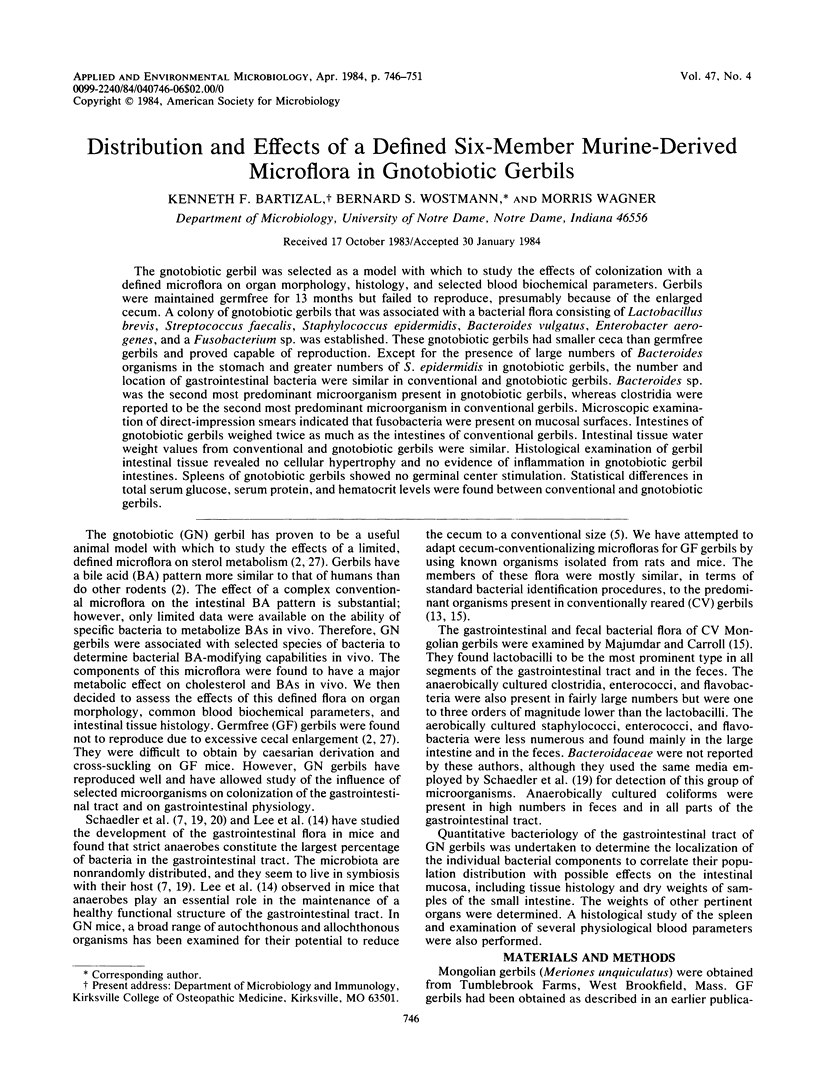
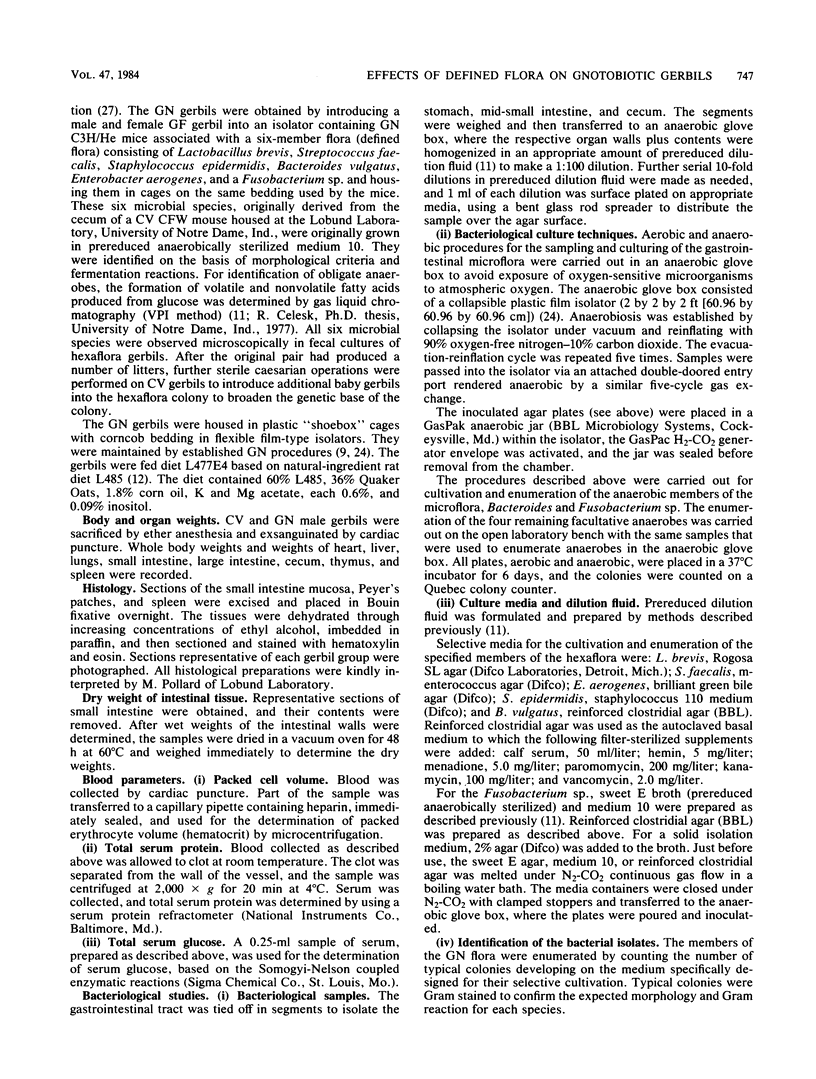
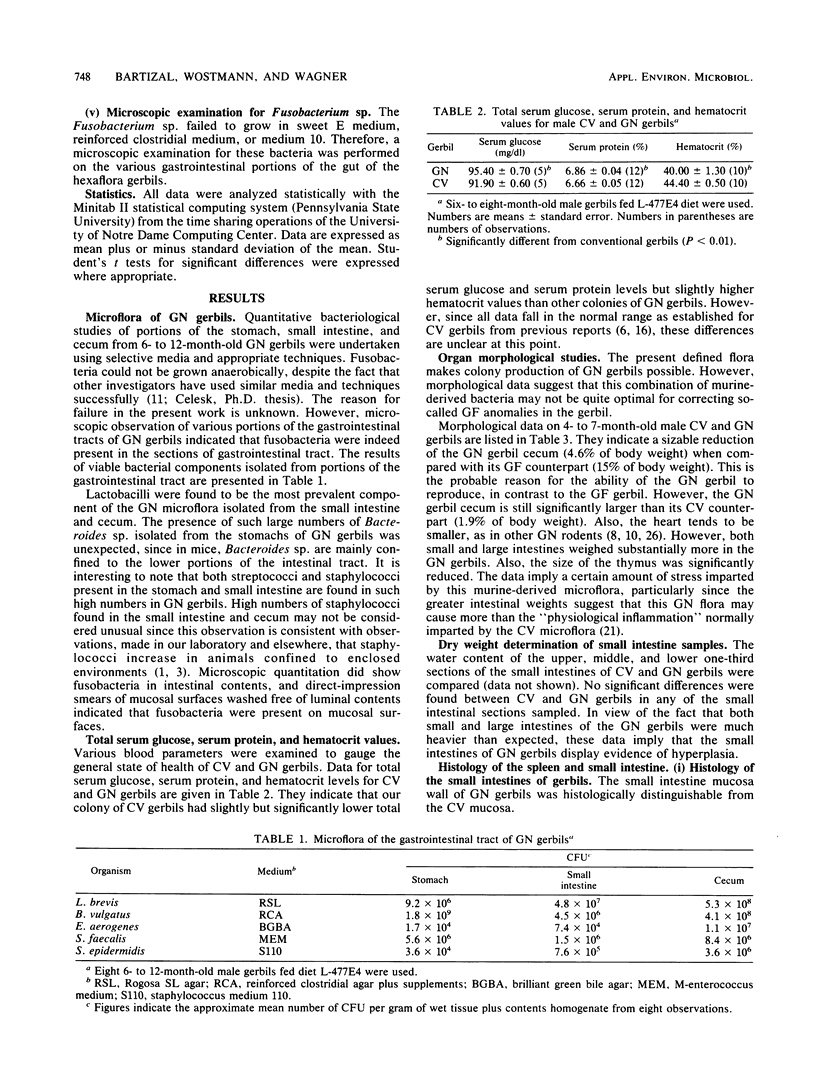
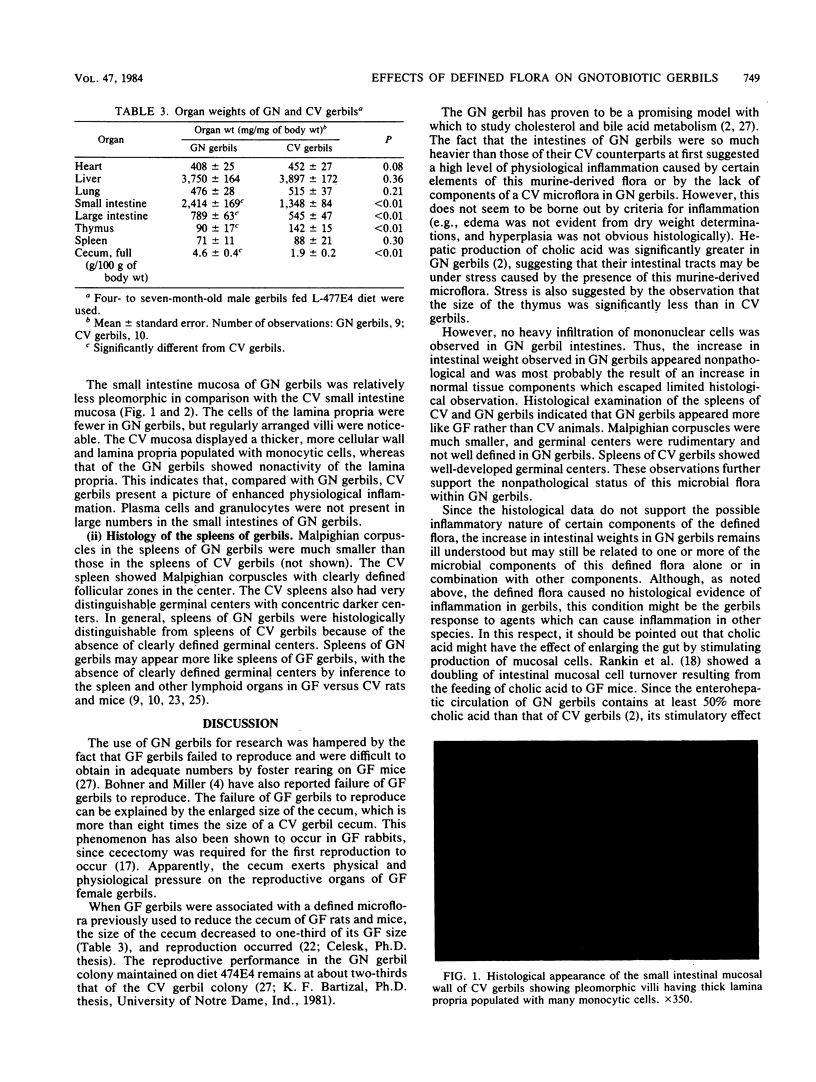
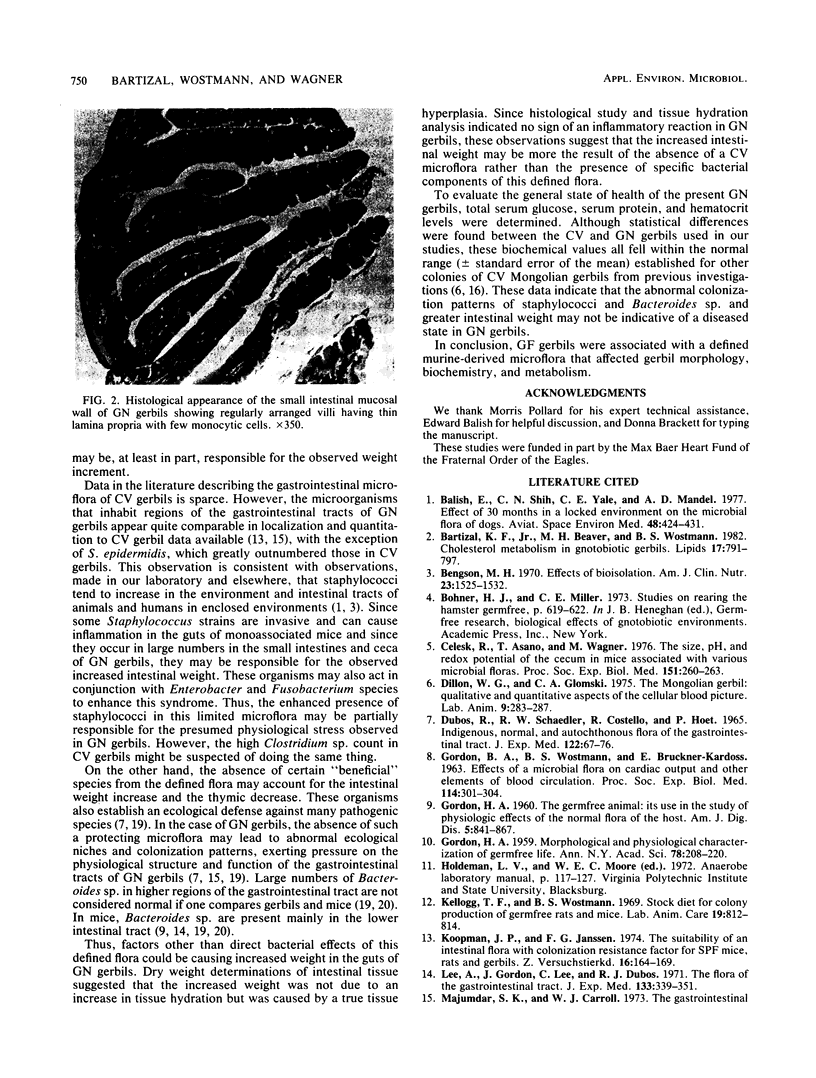
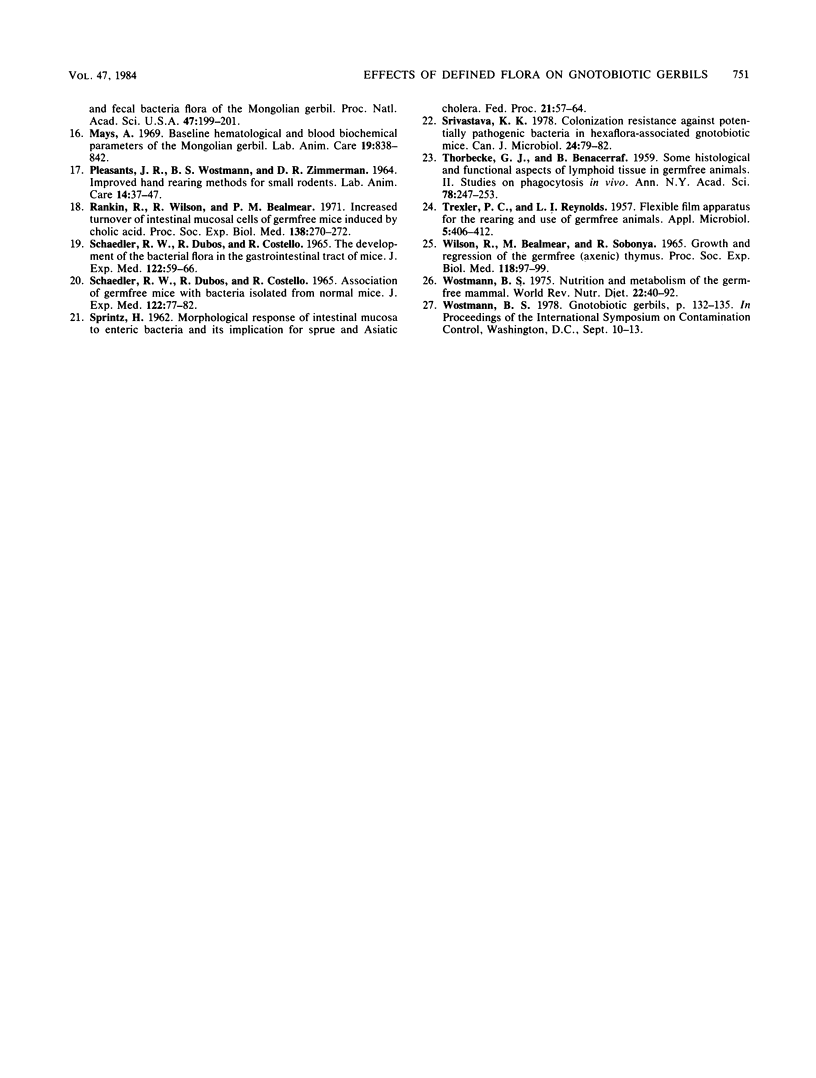
Images in this article
Selected References
These references are in PubMed. This may not be the complete list of references from this article.
- Balish E., Shih C. N., Yale C. E., Mandel A. D. Effect of 30 months in a locked environment on the microbial flora of dogs. Aviat Space Environ Med. 1977 May;48(5):424–431. [PubMed] [Google Scholar]
- Bartizal K. F., Jr, Beaver M. H., Wostmann B. S. Cholesterol metabolism in gnotobiotic gerbils. Lipids. 1982 Nov;17(11):791–797. doi: 10.1007/BF02535355. [DOI] [PubMed] [Google Scholar]
- Bengson M. H. Effects of bioisolation. Am J Clin Nutr. 1970 Nov;23(11):1525–1532. doi: 10.1093/ajcn/23.11.1525. [DOI] [PubMed] [Google Scholar]
- Celesk R. A., Asano T., Wagner M. The size pH, and redox potential of the cecum in mice associated with various microbial floras. Proc Soc Exp Biol Med. 1976 Feb;151(2):260–263. doi: 10.3181/00379727-151-39187. [DOI] [PubMed] [Google Scholar]
- DUBOS R., SCHAEDLER R. W., COSTELLO R., HOET P. INDIGENOUS, NORMAL, AND AUTOCHTHONOUS FLORA OF THE GASTROINTESTINAL TRACT. J Exp Med. 1965 Jul 1;122:67–76. doi: 10.1084/jem.122.1.67. [DOI] [PMC free article] [PubMed] [Google Scholar]
- Dillon W. G., Glomski C. A. The Mongolian gerbil: qualitative and quantitative aspects of the cellular blood picture. Lab Anim. 1975 Oct;9(4):283–287. doi: 10.1258/002367775780957250. [DOI] [PubMed] [Google Scholar]
- GORDON H. A. Morphological and physiological characterization of germfree life. Ann N Y Acad Sci. 1959 May 8;78:208–220. doi: 10.1111/j.1749-6632.1959.tb53104.x. [DOI] [PubMed] [Google Scholar]
- GORDON H. A. The germ-free animal. Its use in the study of "physiologic" effects of the normal microbial flora on the animal host. Am J Dig Dis. 1960 Oct;5:841–867. doi: 10.1007/BF02232187. [DOI] [PubMed] [Google Scholar]
- GORDON H. A., WOSTMANN B. S., BRUCKNER-KARDOSS E. EFFECTS OF MICROBIAL FLORA ON CARDIAC OUTPUT AND OTHER ELEMENTS OF BLOOD CIRCULATION. Proc Soc Exp Biol Med. 1963 Nov;114:301–304. doi: 10.3181/00379727-114-28658. [DOI] [PubMed] [Google Scholar]
- Kellogg T. F., Wostmann B. S. Stock diet for colony production of germfree rats and mice. Lab Anim Care. 1969 Dec;19(6):812–814. [PubMed] [Google Scholar]
- Koopman J. P., Janssen F. G. The suitability of an intestinal flora with colonization resistance factor for SPF mice, rats and gerbils. Z Versuchstierkd. 1974;16(2):164–169. [PubMed] [Google Scholar]
- Lee A., Gordon J., Lee C. J., Dubos R. The mouse intestinal microflora with emphasis on the strict anaerobes. J Exp Med. 1971 Feb 1;133(2):339–352. doi: 10.1084/jem.133.2.339. [DOI] [PMC free article] [PubMed] [Google Scholar]
- Mays A., Jr Baseline hematological and blood biochemical parameters of the Mongolian gerbil (Meriones unguiculatus). Lab Anim Care. 1969 Dec;19(6):838–842. [PubMed] [Google Scholar]
- PLEASANTS J. R., WOSTMANN B. S., ZIMMERMAN D. R. IMPROVED HAND REARING METHODS FOR SMALL RODENTS. Lab Anim Care. 1964 Feb;14:37–47. [PubMed] [Google Scholar]
- Ranken R., Wilson R., Bealmear P. M. Increased turnover of intestinal mucosal cells of germfree mice induced by cholic acid. Proc Soc Exp Biol Med. 1971 Oct;138(1):270–272. doi: 10.3181/00379727-138-35876. [DOI] [PubMed] [Google Scholar]
- SCHAEDLER R. W., DUBOS R., COSTELLO R. THE DEVELOPMENT OF THE BACTERIAL FLORA IN THE GASTROINTESTINAL TRACT OF MICE. J Exp Med. 1965 Jul 1;122:59–66. doi: 10.1084/jem.122.1.59. [DOI] [PMC free article] [PubMed] [Google Scholar]
- SCHAEDLER R. W., DUBS R., COSTELLO R. ASSOCIATION OF GERMFREE MICE WITH BACTERIA ISOLATED FROM NORMAL MICE. J Exp Med. 1965 Jul 1;122:77–82. doi: 10.1084/jem.122.1.77. [DOI] [PMC free article] [PubMed] [Google Scholar]
- SPRING H. Morphological response of intestinal mucoss to enteric bacteria and its implication for sprue and Asiatic cholera. Fed Proc. 1962 Jan-Feb;21:57–64. [PubMed] [Google Scholar]
- Srivastava K. K. Colonization resistance against potentially pathogenic bacteria in hexaflora-associated gnotobiotic mice. Can J Microbiol. 1978 Feb;24(2):79–83. doi: 10.1139/m78-016. [DOI] [PubMed] [Google Scholar]
- THORBECKE G. J., BENACERRAF B. Some histological and functional aspects of lymphoid tissue in germfree animals. II. Studies on phagocytosis in vivo. Ann N Y Acad Sci. 1959 May 8;78:247–253. doi: 10.1111/j.1749-6632.1959.tb53107.x. [DOI] [PubMed] [Google Scholar]
- TREXLER P. C., REYNOLDS L. I. Flexible film apparatus for the rearing and use of germfree animals. Appl Microbiol. 1957 Nov;5(6):406–412. doi: 10.1128/am.5.6.406-412.1957. [DOI] [PMC free article] [PubMed] [Google Scholar]
- WILSON R., BEALMEAR M., SOBONYA R. GROWTH AND REGRESSION OF THE GERMFREE (AXENIC) THYMUS. Proc Soc Exp Biol Med. 1965 Jan;118:97–99. doi: 10.3181/00379727-118-29766. [DOI] [PubMed] [Google Scholar]
- Wostmann B. S. Nutrition and metabolism of the germfree mammal. World Rev Nutr Diet. 1975;22:40–92. doi: 10.1159/000397975. [DOI] [PubMed] [Google Scholar]




